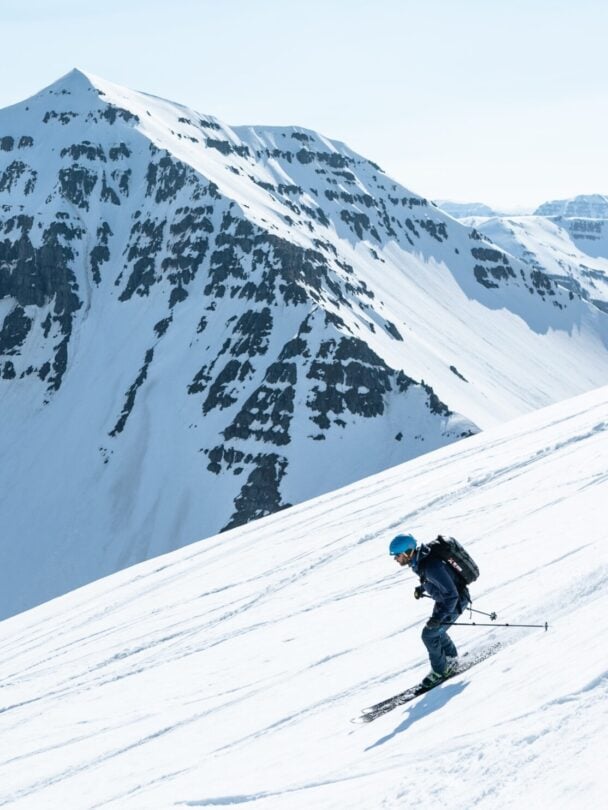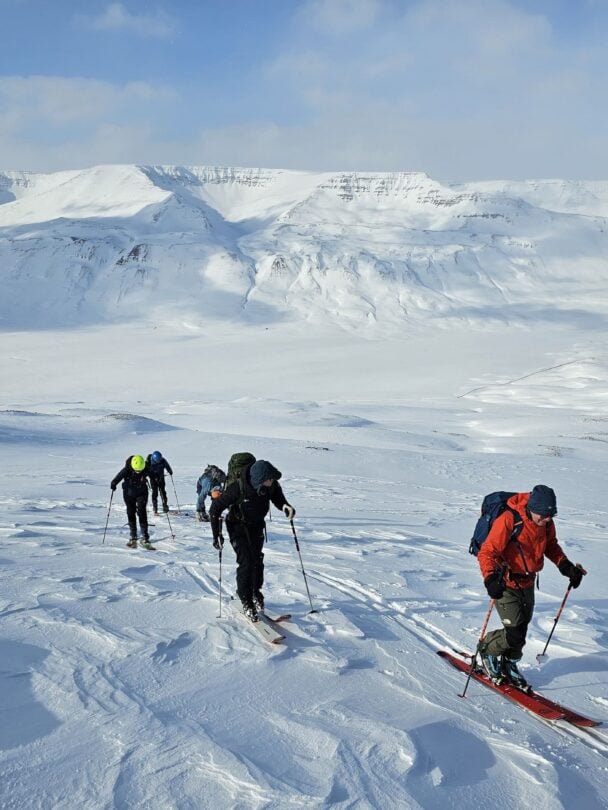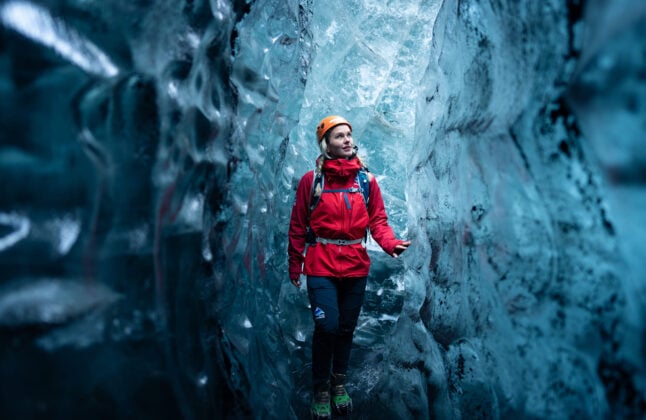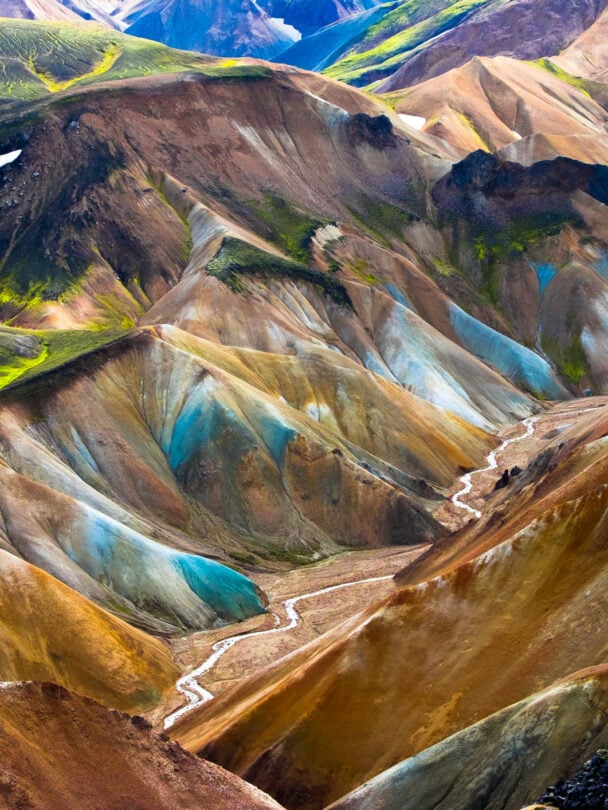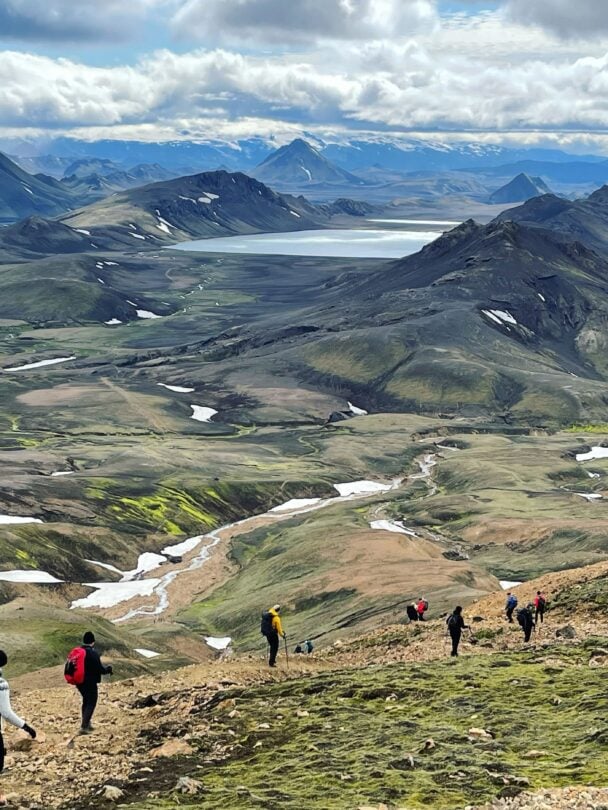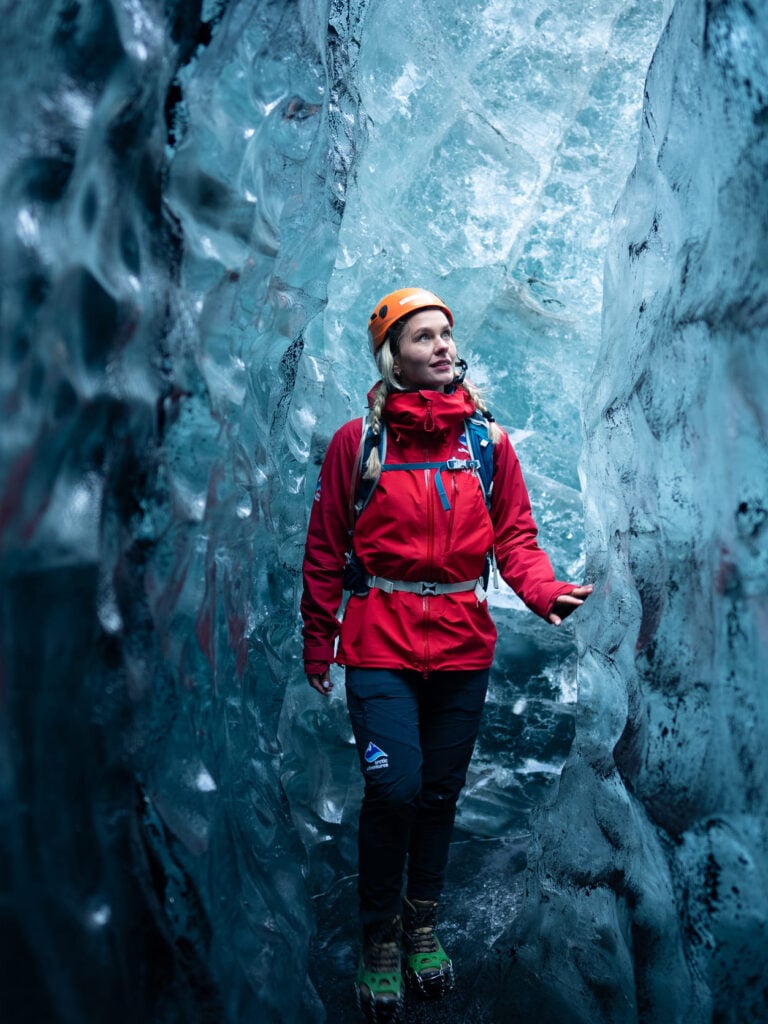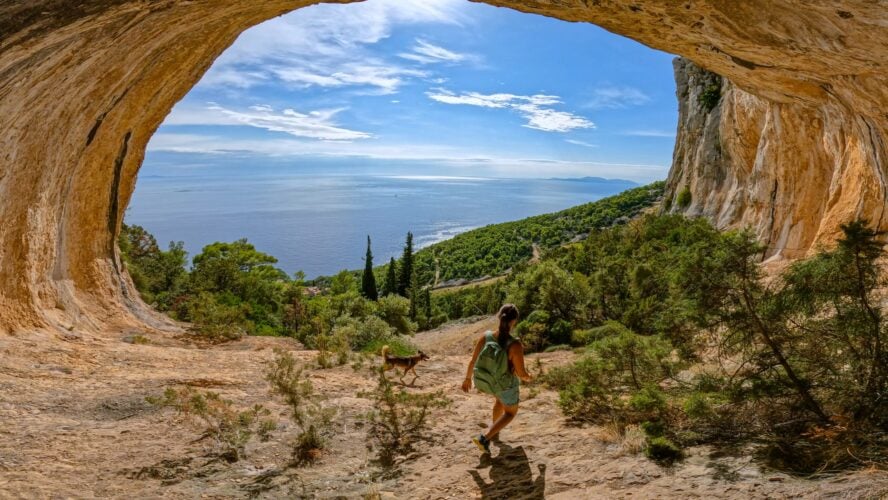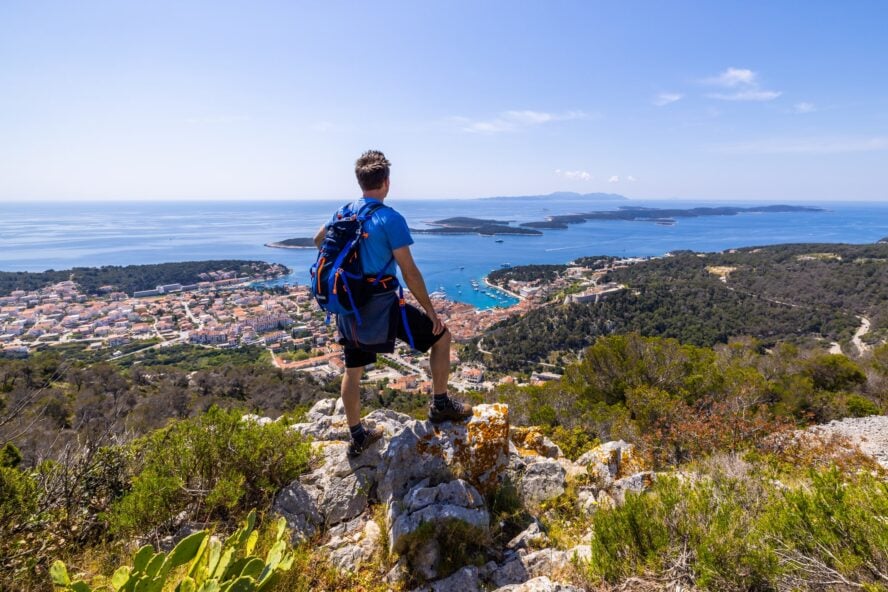Iceland is a land that never stops moving.
Glaciers creep, geysers erupt, volcanoes rumble, and weather turns on a dime. It’s a country where adventure isn’t optional, it’s built into the DNA of the landscape. Whether you’re strapping on skis in the north, paddling through wild fjords in the Westfjords, or hiking lava fields still warm from eruptions, Iceland delivers a raw, wild thrill no matter the season.
Each year, over a million travelers come here to chase the kind of landscapes that don’t feel real until you see them. But Iceland isn’t just about ticking sights off a “what to do” list. It’s about immersing yourself in the raw, untamed wilderness.
What to do in Iceland? Depends on when you’re visiting
Iceland is never still, and neither are its adventures.
In winter, the country becomes an ice kingdom, ideal for ski touring, ice caving, and aurora chasing. Come Spring, valleys bloom, rivers swell, and adventurers can ski in the morning and hike in the afternoon.
In the Summer, June through August, the highlands open under 24-hour light — it’s prime time for epic treks and fjord kayaking. Autumn means golden tundra, moody skies, and the aurora’s return make for stunning, quieter journeys.
Iceland’s weather is unpredictable. Always dress in breathable layers, waterproof shells, and sturdy boots, even in mid-summer.
What to Do in Iceland in January
January brings Iceland into the deep freeze of midwinter. The days are still short — around 4–5 hours of light — but the long nights are aurora-friendly, and the snowpack is building steadily in the north and highlands.
It’s a month of dramatic contrasts: frozen waterfalls, steam rising from geothermal fields, and powder-covered mountains waiting for tracks.
Ski Touring in the North
The Troll Peninsula and the mountains around Akureyri are in full winter mode by January. With deep snowpacks you get endless touring options: mellow fjord descents, steep couloirs, and wide-open ridges.
While daylight is limited, local guides can plan efficient outings. They’ll maximize vertical while keeping a keen eye on avalanche conditions. Expect cold, dry powder and the chance to skin straight from the shoreline into alpine terrain.
Even with limited daylight, you’ll often squeeze in 1,000–1,500 vertical meters — then cap it off with a dip in Akureyri’s geothermal pools.
Ice Caving in Vatnajökull
January is prime season for exploring Vatnajökull’s ice caves. The blue ice is hard and stable; the caves are at their most spectacular, and the low winter light filtering through the glacier’s roof creates surreal, turquoise hues. Some tours even combine ice caving with glacier hikes, which means you’ll get to crunch across crevasse fields before ducking underground.
Frozen Waterfall Adventures
Few sights scream “Iceland in winter” like the frozen walls of Gullfoss or Goðafoss. In January, many of the island’s waterfalls partially freeze, creating ice curtains and crystalline towers. You can also try ice climbing on frozen falls in the Skaftafell area. A thrilling, vertical way to experience Iceland’s frozen landscapes.
Aurora Hunting on Snowshoes
With nearly 20 hours of darkness, January is perfect for hunting for the northern lights in Iceland. Some operators offer snowshoe tours at night: crunching through snow-dusted lava fields while the northern lights ripple above. Pair that with a thermos of hot chocolate, and it’s the ultimate winter memory.
What to Do in Iceland in February
February eases toward longer days — around 7–8 hours of light — but it’s still full-on winter. Snow is deep across the north, the ice caves are stable, and the festivals add a cultural spark. Weather swings from bluebird calm to fierce storms, but that unpredictability is part of Iceland’s charm. You’ll get used to it.
Heli-Skiing in the Troll Peninsula
By February, the snowpack is deep enough for heli-ski operators to run more consistently. This is the month where big lines start to come into play; 1,000+ meter descents from sharp ridges straight to the sea.
The long twilight hours stretch the skiing window. Between flights, you can warm up in rustic mountain lodges or Iceland’s legendary hot springs. Storm days happen, but when skies clear, the payoff is endless fresh powder and jaw-dropping scenery.
Glacier Hiking and Ice Climbing
Vatnajökull and Langjökull glaciers are prime for full-day glacier hikes in February. Crampons crunch everywhere across wind-sculpted snowfields, and many explorers choose to do some short ice climbs on seracs or frozen walls.
With more daylight, these trips feel less rushed compared to December and January.
Snowmobiling on Glaciers
Snowmobiling across Langjökull or Mýrdalsjökull is pure adrenaline. February’s thick snow cover means smoother, faster rides across the white expanse. Many tours combine snowmobiling with stops at ice caves or frozen craters, turning a thrill ride into a full exploration day.
Try the Aurora and Culture Combo
February also brings Þorrablót, a midwinter feast of traditional Icelandic foods. Pair an aurora tour with this cultural celebration, and you’ll sample fermented shark, smoked lamb, and Brennivín (Iceland’s “black death” schnapps) before heading out under the stars.
What to Do in Iceland in March
March feels like the turning point of the season. Daylight stretches past 12 hours by the end of the month, yet snow still blankets the north and highlands. It’s one of the best times for adventure — long days, stable snow, and still excellent chances for auroras.
Spring Ski Touring
March is prime ski touring season in Iceland. The Troll Peninsula, the Westfjords, and mountains near Siglufjörður all shine this month. You’ll skin under the lengthening daylight, linking multiple descents in a single tour.
The snowpack is often stable enough for bigger objectives, and the long days mean more vertical without the rush.
Expert tip: Sunset runs are a March highlight. Golden-hour light lingers for ages, painting the fjords in fire as you descend.
Longer Ice Cave Journeys
While late March signals the end of the ice cave season, this is actually the perfect month for longer combo trips. You can hike across Vatnajökull’s glacier plateaus for hours before reaching hidden caves, and experience both above- and below-glacier landscapes in one push.
Super-Jeep Into the Highlands
With more daylight and improving conditions, super-jeep tours can push deeper into the highlands in March. You’ll rattle across snow plains to geothermal wonders like Landmannalaugar, where hot springs steam in the snow. March trips feel like expeditions — remote, challenging, and wildly rewarding.
Aurora Hunting’s Last Hurrah
March is often the last good month for aurora tours before the nights get too short. Many locals combine it with winter hikes or photography tours to make the most of the final long nights. Imagine standing on a frozen lake under curtains of green and purple. It’s the definition of Icelandic magic.
What to Do in Iceland in April
April is a month of contrasts in Iceland. Winter still lingers in the north and on the glaciers, while the south and coastal areas start to bloom with early signs of spring. The days stretch to 13–16 hours of light, opening up more time for adventure.
You can still enjoy winter sports, but also start dipping into shoulder-season activities with fewer crowds.
Ski Touring and Snowboarding in the North
For powder chasers, April is one of the best times to visit the Troll Peninsula. Snowpack is deep and stable, with longer daylight hours allowing for big objectives. You’ll skin up ridges overlooking Eyjafjörður, descend wide-open faces, and maybe even catch corn snow on sunnier aspects.
Some trips mix ski-touring days with a boat-supported adventure, skiing straight to the ocean.
Pro tip: Guides recommend bringing sunglasses and sunscreen along with avalanche gear — spring sun can be intense, especially when bouncing off snow.
Ice Caving in Vatnajökull
April is the final month for stable ice caves before warming temps make them unsafe. This is your last chance to see the brilliant sapphire chambers inside Vatnajökull.
Guides lead small groups through cathedral-like caves, explaining glacial movement as you photograph walls that glow in filtered light. By late April, some tours combine caving with short glacier hikes.
Why April? You get the caves at their most dramatic before they collapse, with more daylight for exploration.
Puffin Watching on the Westman Islands
Migratory birds begin arriving in April, and puffins — Iceland’s most famous seabirds — make their first appearance toward the end of the month. The Westman Islands are the best spot to see them, with cliffs and sea stacks alive with squawking colonies.
You can take a boat tour around Heimaey or hike to cliffs for close-up views.
Expert tip: Bring binoculars and a telephoto lens — puffins are shy and best admired from a distance.
Waterfall Touring in Full Flow
With spring thaw underway, Iceland’s waterfalls roar at maximum volume in April. Gullfoss, Skógafoss, and Dettifoss are particularly impressive, fed by melting snow. Spray can drench you head to toe, so waterproofs are essential. The combination of icy mist and fresh greenery makes for stunning photography.
Pro tip: Sunrise and sunset last longer this month — plan waterfall visits for golden light.
What to Do in Iceland in May
May marks the start of Iceland’s true spring. Days stretch to nearly 20 hours of daylight, giving you endless time to explore. Roads become more accessible, wildflowers start to bloom, and bird colonies swell. Snow lingers on higher peaks, making May a hybrid month where you can ski one day and hike in green valleys the next.
Hiking in Thórsmörk Valley
By May, Þórsmörk starts waking from winter. Trails open up, revealing a lush valley between glaciers. Birch forests sprout fresh leaves, rivers swell with meltwater, and snow still glints on nearby peaks.
Many visitors choose to combine jeep transfers with valley walks for a mix of accessibility and wild adventure. Pro tip: wear waterproof boots. Snowmelt makes trails muddy and river crossings lively.
Whale Watching in Husavík
May is prime time to see humpback whales feeding in northern fjords. Tours from Húsavík — the whale-watching capital — regularly spot minke, humpbacks, and sometimes blue whales. With calmer seas and mild temps, conditions are ideal for wildlife encounters.
Why May? Fewer tourists mean quieter tours, and whale activity ramps up as nutrient-rich waters lure pods closer to shore.
Ski Touring & Corn Snow Missions
Spring skiing continues strong in May. By now, snow has softened into perfect corn. Smooth, buttery slopes ideal for long, flowing turns. Ski guides love May because stable conditions allow for big link-ups, sometimes skiing multiple fjords in a single day.
May offers some of the best ski-to-sea descents. Don’t miss a photo with your skis touching black-sand beaches.
Birdwatching on Látrabjarg Cliffs
In the Westfjords, Látrabjarg cliffs come alive in May as puffins, guillemots, and razorbills nest in huge numbers. These cliffs are Europe’s largest seabird colony, and birds perch so close you can practically make eye contact. May evenings offer long, golden light — magical for photography.
Pro tip: Stay quiet and move slowly — puffins are surprisingly approachable if you give them space.
What to Do in Iceland in June
June means midnight sun. With 21–22 hours of daylight, Iceland feels endless. Hikes can start at 10 p.m., and golden-hour light lingers all night. Snow is retreating to the highest peaks, flowers carpet the valleys, and summer festivals kick off. June is the month of abundance, when every corner of Iceland seems alive.
Hiking the Laugavegur Trail (Early Season)
By late June, Iceland’s most famous trekking route, the Laugavegur Trail, starts to open. Early-season treks mean some snowfields remain, but landscapes are vibrant with geothermal colors and wildflowers. Multi-day guided trips include mountain huts, glacier crossings, and steaming hot springs.
Bring gaiters for snow sections and be ready for fast-changing weather.
Kayaking in the Westfjords
June is perfect for paddling among fjords, sea cliffs, and remote coves. The Westfjords offer solitude, with chances to see seals lounging on rocks and arctic terns swooping overhead. Multi-day kayak tours let you camp on secluded beaches under the midnight sun. A surreal experience.
Why June? Stable seas and endless light make long-distance paddles both safe and spectacular.
Climbing in Hvalfjörður and Esja
Rock climbing season kicks off in June, with dry crags and mild temps. Hvalfjörður, just north of Reykjavik, offers multi-pitch trad routes with ocean views. Mount Esja has scrambly lines perfect for mixed climbing.
Plus, evening climbs under midnight sun mean you’ll often have crags to yourself.
Horseback Riding Under the Midnight Sun
Icelandic horses are famous for their tölt gait, and June is the best time to ride them across blooming meadows and black-sand beaches. Evening rides under the midnight sun feel dreamlike: golden light, long shadows, and rivers reflecting pink skies.
Pro tip: Even in summer, temps drop at night. Dress in layers to enjoy your ride comfortably.
Festival Hopping in Reykjavik
June is also cultural season. Reykjavik hosts arts festivals, music events, and Independence Day celebrations on June 17. Between outdoor concerts and lively street parades, the capital buzzes with energy.
What to Do in Iceland in July
July is Iceland’s high summer. The land is soaked in the midnight sun.
With nearly 24 hours of daylight, you’ll have endless opportunities to explore glaciers, waterfalls, volcanoes, and black-sand beaches without the pressure of darkness falling. The weather is mild by Icelandic standards, with average highs around 12–15°C (though it can feel warmer in the sun).
This is the peak season for hiking, festivals, and any multi-day adventure, really.
Hiking the Laugavegur Trail
The famous Laugavegur Trail is fully open in July, thanks to snowmelt clearing the mountain passes. Stretching 55 km between Landmannalaugar and Þórsmörk, it offers steaming geothermal vents, rhyolite mountains in every shade of orange and green, and black deserts that feel lunar.
Guided hikes often include hut stays or camping, with meals prepared in the wild. July’s long days let you hike at your own pace, stopping to soak in hot rivers or photograph pastel sunsets that never fully fade.
Trails can still be muddy from snowmelt, so gaiters help. Book huts months ahead, as they sell out fast in summer, or go for a guided Iceland hiking tour.
Puffin & Whale Watching
July is prime wildlife month. Puffins are nesting on cliffs around Dyrhólaey and the Westman Islands, easily spotted with their colorful beaks as they fish for their chicks. Out at sea, whale-watching tours from Húsavík often encounter humpbacks, minkes, and even blue whales.
On calm evenings, you might even spot whales silhouetted against the midnight sun. A photographer’s dream. Morning tours tend to be calmer for seasickness-prone travelers, but evening trips under the glowing sky are unforgettable.
Ice Climbing on Sólheimajökull Glacier
While the lowlands bask in summer, the glaciers stay icy year-round. July is a great time for beginner-friendly glacier hikes and ice climbing on Sólheimajökull.
If you’re new, go with a guide. They’ll show you how to use crampons and ice axes, then lead you up shimmering blue walls of ice. Meltwater rivers carve surreal formations, which makes the landscape different every week.
Why July works: Stable conditions and warmer temps mean you won’t freeze between climbs, but the glacier still holds its shape.
River Rafting in North Iceland
The glacial rivers near Varmahlíð and Húsafell roar strongest in July. Rafting trips here are fast, fun, and often cold, but that’s part of the thrill. You’ll suit up in drysuits and paddle Class III–IV rapids.
Some trips even end with cliff jumps into glacial meltwater pools, a proper Icelandic wake-up call.
Family-friendly rafting options exist as well, with gentler floats down calmer rivers.
What to Do in Iceland in August
August is still summer, but with a softer edge. The midnight sun begins to wane, nights grow darker (a bonus for aurora hunters), and the landscape is lush with late-summer greens.
It’s harvest season in the countryside, berry-picking time for locals, and still excellent for long adventures in the Highlands. Weather is unpredictable — sunny one moment, stormy the next — but that’s Iceland.
Multi-Day Trekking Alongside Iceland’s Volcanic Trails
By August, remote Highland routes like Askja and the volcanic interior are snow-free and at their most accessible. You can trek to Víti Crater, where geothermal water fills a turquoise lake inside a volcanic bowl, or explore the Ódáðahraun lava desert, one of the largest in Iceland.
This is true wilderness: black volcanic plains, steaming vents, and rivers that sometimes need to be forded.
Aurora Season Begins
From mid-August onward, darkness creeps back, bringing the first northern lights of the season. It feels surreal: you can still hike in relative warmth during the day, then spot auroras at night. Many tours combine activities — like horseback riding or kayaking — with late-night aurora hunts.
Pro tip: Early-season auroras are often faint, so photographers should bring a tripod and wide-aperture lenses.
Sea Kayaking
August offers calmer seas for kayaking along the dramatic fjords. Here, you paddle under towering cliffs, sometimes alongside seals, porpoises, and seabird colonies. Campsites dot the shoreline, and some expeditions visit remote villages where time feels frozen.
Why August? The weather is relatively mild, and long twilight evenings make multi-day trips more relaxed.
Glacier Hiking on Vatnajökull
With stable summer conditions, Vatnajökull — Europe’s largest glacier — is prime for guided glacier hikes. You’ll rope up with a guide, cross crevasses, and peer into moulins (deep blue shafts where meltwater disappears).
Some tours even combine glacier hikes with ice cave exploration, though caves are smaller than in winter.
Pro tip: Bring sunglasses. Glacier glare is intense in August sunshine.
What to Do in Iceland in September
For many visitors, September is the sweet spot: fewer tourists, cooler weather, and landscapes painted in autumn colors. Golden birch forests, crimson moss, and snow-dusted peaks make it one of the most photogenic months.
Daylight lasts 12–14 hours — perfect balance for both daytime adventures and nighttime aurora hunting.
Hiking in Þórsmörk and Landmannalaugar
By September, Þórsmörk valley glows with autumn foliage. Trails are quieter than in July, but still accessible. You’ll hike past braided rivers, black ridges, and golden birch forests.
Landmannalaugar is also stunning this time of year, with fewer crowds on the rhyolite slopes and hot springs perfect for warming up after chilly hikes.
Pro tip: Nights are colder — bring a warmer sleeping bag if camping, or book huts early as they close by late September.
Northern Lights & Cozy Nights
The aurora season kicks into full gear. Darker nights and clear skies make September one of the best months for seeing the lights without freezing. Tours often combine aurora hunts with jeep rides, glacier lagoons, or boat trips.
Horseback Riding Through Autumn Colors
Icelandic horses are legendary, and September is peak time to ride through colorful valleys and along black-sand beaches. The tölt — their unique smooth gait — makes long rides comfortable. Some tours even include sheep round-ups (réttir), where locals gather flocks from the mountains. Joining one gives you a hands-on glimpse of rural traditions.
Exploring Glacier Lagoons (Jökulsárlón)
Jökulsárlón is spectacular year-round, but in September the icebergs are backlit by golden sunsets. You can take zodiac boat rides among drifting icebergs, some streaked with volcanic ash, or kayak quietly between them. Seals often swim close, curious but cautious.
Why September? Fewer crowds mean a more tranquil experience in this famous spot.
What to Do in Iceland in October
October is a month of contrasts in Iceland. Not quite the depths of winter, but no longer the mild days of summer. The first snow often dusts the highlands, autumn colors linger in the lowlands, and the aurora begins to paint the skies again.
Days shorten quickly, averaging 8–11 hours of daylight, making it the perfect balance of daytime adventure and nighttime wonder.
Hiking in Þórsmörk’s Autumn Colors
Before deep winter snows arrive, Þórsmörk valley glows with golden birch leaves and crisp mountain air. Trails weave past braided rivers, volcanic ridges, and glacier tongues, all framed by autumn’s last colors.
In October, guided hikes may involve river crossings and some icy patches, but the reward is solitude and dramatic landscapes untouched by summer crowds.
Why October: Þórsmörk becomes a quiet sanctuary. You’ll share the valley mostly with ravens and the crunch of your own boots.
Glacier Walking and Ice Climbing
October is an excellent time to explore Iceland’s glaciers. You can head to Sólheimajökull or Falljökull, where crisp, cold nights harden the ice, making crevasses and ridges more stable to navigate. For thrill-seekers, beginner-friendly ice climbing sessions are available — you’ll strap on crampons, wield an ice axe, and scale a frozen wall with expert guidance.
Pro tip: October weather can change fast, so tours often include all necessary safety gear and contingency plans.
Aurora Hunting on Clear Autumn Nights
With long nights returning (up to 15 hours by the end of the month), the northern lights are back in full swing. October skies can be crisp and clear, and guided tours head into areas with minimal light pollution — think Thingvellir, Snæfellsnes, or the south coast. Some tours add creative twists, like photography coaching or hot spring stops to soak while you wait.
Why it’s memorable: Autumn auroras often dance above colorful landscapes, mixing northern lights with the last fiery leaves.
Whale Watching from Reykjavík or Akureyri
While summer is peak whale-watching season, October is a quieter time to head out on the water. Minke whales, humpbacks, and dolphins are still active, and the North Atlantic in autumn has a raw, untamed beauty. Fewer boats mean calmer, more personal encounters with the wildlife.
Insider’s note: Pack an extra-warm layer — October winds on the water can bite, even with provided overalls.
What to Do in Iceland in November
November marks the start of true winter in Iceland. Days are short — just 5–7 hours of daylight — but nights are long, dark, and alive with auroras. Snow begins to settle across the landscape, which makes it feel magical and wild. Crowds are minimal, so adventures feel more personal and authentic.
Ice Caving Season Kicks Off in Vatnajökull
By November, ice caves start to stabilize and open for guided exploration. Deep under Vatnajökull, Europe’s largest glacier, meltwater has carved tunnels of sapphire blue and glassy walls that glitter like frozen cathedrals. Tour guides will provide crampons, helmets, and expert guidance to keep the experience safe and awe-inspiring.
Why November: It’s early enough that you often get quieter caves, without the peak-season winter crowds.
Ski Touring on Early Snow in the North
Up in the north, snow often comes back by November, allowing for the first ski touring missions of the season. Conditions can be variable, so you should opt to look for the best slopes with a guide, from gentle bowls to steeper couloirs overlooking the fjords. Just know that while some days might involve skinning through thin cover, others reward you with perfect powder runs.
Pro tip: November ski touring is best with flexible plans. It’s a good idea to mix skiing with hot springs, aurora viewing, or coastal hikes, depending on snow levels.
Northern Lights and Winter Stargazing
November offers some of the longest nights of the year — up to 19 hours of darkness — making it prime time for northern lights hunting. With snow now blanketing much of the countryside, the reflections add extra brightness and drama to the aurora show. Many choose to head into the countryside with jeeps, snowshoes, or even dog sleds to combine the chase with an Arctic adventure.
Lava Tube and Ice Cave Combos
Iceland’s volcanic underworld is just as fascinating as its glaciers. In November, some tours combine lava tube exploration — walking through ancient magma tunnels lined with colorful rock — with ice cave adventures on nearby glaciers. It’s the best of both worlds: fire and ice in a single day.
Cozy Hiking in Þórsmörk’s Frosty Silence
By November, Þórsmörk is cloaked in snow and frost. Guided jeep-supported hikes take you into the valley, where the birch forests sparkle with rime and volcanic ridges stand stark against the white. It’s cold, raw, and silent — but the reward is total solitude and views few travelers ever witness this late in the year.
Expect challenging conditions, but also a level of wild beauty that summer crowds never get to see.
What to Do in Iceland in December
December wraps Iceland in winter’s grip. Days are short (around four hours of light!), but the long nights open up endless aurora opportunities. It’s also the month of Jól, Iceland’s Christmas season, a time when folklore and modern celebrations fill villages with cozy light.
Ski Touring and Heli-Skiing on the Troll Peninsula
In December, you’ll find powdery slopes dropping straight toward the sea, a rarity in the ski world. Heli-skiing lets you squeeze multiple runs into the short daylight, while ski touring offers a slower-paced way to earn your turns.
Exploring Ice Caves in Vatnajökull
Ice caves here are like frozen cathedrals; translucent walls, deep blues, and sculpted textures formed by meltwater tunnels. December is the safest time to explore them, because the cold temperatures serve to stabilize the structures. Tours usually involve a super-jeep ride across the glacier, crampon hiking, and time inside surreal, glittering chambers.
Aurora Hunting in Long Nights
Auroras often peak in December. Guides head to places like Snæfellsnes Peninsula, away from Reykjavik’s glow. On clear nights, the sky explodes with green, pink, and purple ribbons — a light show you’ll never forget.
Super-Jeep Adventures in the Highlands
With roads closed to regular cars, super-jeeps become the only way to reach Iceland’s remote interior. These oversized rigs climb snowy ridges and ford frozen rivers to reach geothermal oases like Hveravellir, where you can soak in hot springs while snow swirls around.
Snow Hikes in Þórsmörk
Though most trails are snowbound, crampons and guided support make Þórsmörk hikes possible. You’ll see glaciers spilling into valleys, volcanic ridges powdered white, and birch forests sparkling with frost. The silence here is profound.
What will you choose to do in Iceland?
Iceland reinvents itself every month. December’s glowing ice caves, July’s midnight-sun treks, September’s fiery foliage. No two seasons are the same, and no adventure repeats itself. This island thrives on extremes, and so do the people who travel here.
So whether you’re strapping skis on in January or hiking under the midnight sun in July, Iceland is ready. The only thing left is to choose your season and let the adventure unfold.









